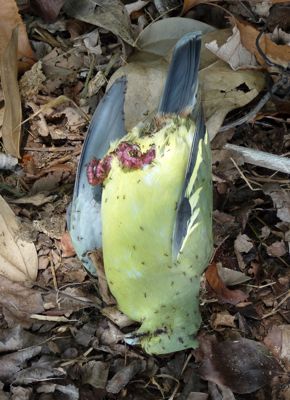Facts:
“On 25th February 2010 at 10:30 hours I was bicycling along Mandai Road and saw what looked to be two birds flapping on the ground up ahead next to the track. This is a wooded stretch with large trees and branches hanging over the trail. I could see wings beating in the leaf litter; I mistook the event for two birds fighting on the ground. When I slowly got closer to investigate I saw a brown animal with a reddish head curled around a bird and holding it down. The long tail was wrapped around it like a snake. As I got too close, the animal released its grip and scuttled into the woods, I could see it was a male Changeable Lizard (Calotes versicolor).
“This lizard occurs naturally on the Indian subcontinent, south-east into Thailand and northern Peninsular Malaysia. It is believed to be introduced into Singapore, where it is now common. It feeds on insects and even small lizards according to Baker & Lim (2008).
“When I looked at the bird I saw it was a female Pink-necked Green Pigeon (Treron vernans) (left top). It was gasping for air, the tail was bent backwards against its back. There were no visible wounds except a bite-mark on the back of the head (left bottom).
“According to Wells (1999): “Like other green pigeons (the Pick-necked Green Pigeon), hardly ever descends to the ground.”
I returned to the site again 2½ hours later with a camera. The pigeon had died and was being attacked by ants. There was no sign of the lizard.”
Speculation:
“Most likely the lizard attacked the pigeon on a branch in the tree above the trail and they fell to the ground. The flapping I saw was the pigeon trying to take off again. The puncture wound on the head was enough to kill the pigeon, but the lizard never returned to feed on its prey.
“It would be interesting to know if there are other cases of this invasive lizard species predating on birds.”
Morten Strange
Singapore
March 2010
References:
1. Baker, N. & Lim, K. (2008) Wild Animals of Singapore. Draco Publishing, Singapore.
2. Wells, D. R. (1999) The Birds of the Thai-Malay Peninsula. Volume One. Christopher Helm, London.










